(TITC) - Located in the northeast of Quy Nhon City, Phuong Mai Peninsula, once before a wild place of Binh Dinh Province in the South-Central Coast Region, has been now an attractive destination for tourists and as well as investors.

Thi Nai Bridge is the second longest sea-crossing bridge in Viet Nam. Photo: internet
Lying to the east of Thi Nai Lagoon, Phuong Mai Peninsula acts as a giant screen to shield Quy Nhon City. The peninsula includes 3 communes of Nhon Ly, Nhon Hoi, Nhon Hai and Hai Cang ward.
Phuong Mai Peninsula is a low mountain area with many undulating peaks. The highest is the 361m high Den Mount, and some other peaks such as Mai and Diep Chu... Phuong Mai mountain is connected to the Trieu Chau range by a mountain range of 2 km long, the narrowest place is only 500m wide called Eo Vuoc. The southern end of the peninsula looks like a spear-shaped blade, with many craggy rock holes, where swiftlets often flock to nest. This place is named Mui Mac (Spear Cape) or Mui Yen (Swiftlet Cape). The northwest mountain range of Mui Mac has a small branch, like a tiger's fang, called Ganh Ho (Tiger Rapids). Sandwiched between these two mountain ranges, there is a rather large freshwater basin.
To get to Phuong Mai Peninsula, from Quy Nhon, visitors go through 5 bridges and Thi Nai Bridge with a total length of 7km. Of which Thi Nai Bridge is considered as proud of Binh Dinh people by its beauty and the second longest sea-crossing bridge in Viet Nam, with 54 spans and 2,477.7 meters long crossing Thi Nai Lagoon and connecting Nhon Hoi economic zone with Quy Nhon City. When connecting by road traffic, Phuong Mai Peninsula becomes more and more attractive land with many big projects to invest in economic, urban and tourism development.
Phuong Mai Peninsula possesses diverse and unique tourist attractions, with mountains, seas, islands, many pristine beaches with blue sea, stretches of sand dunes, beautiful coral reefs, peaceful fishing villages, and also mysterious relic sites.
Nhon Ly Beach
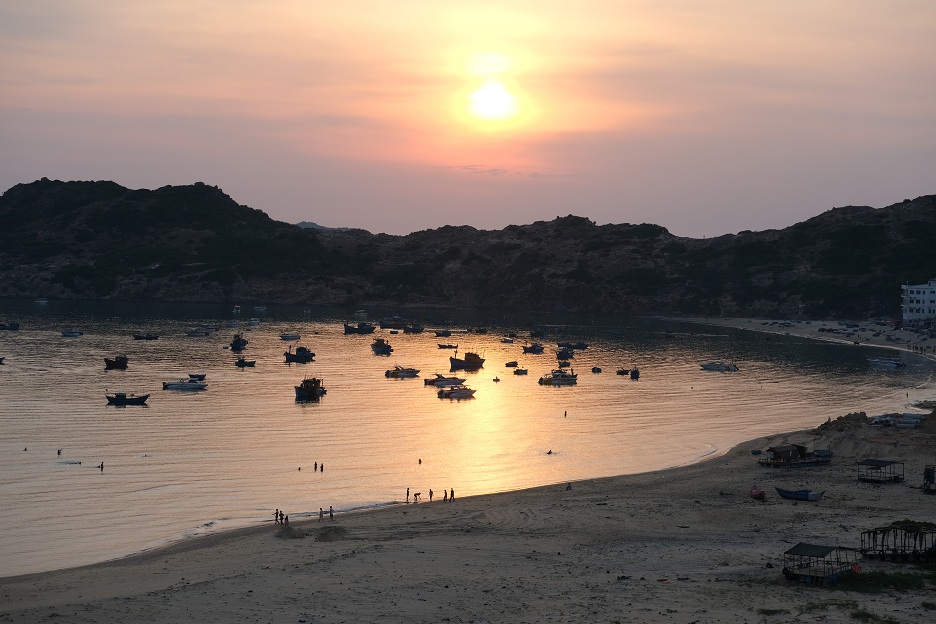
Nhon Ly Beach. Photo: TITC
Nhon Ly Beach (also known as Cat Tien Beach), is well-known for its impressive natural landscape and lush pine forests. The natural scenery is diverse along the length of the beach, the pure white sand dunes, the smooth black magical sandbank, unique pebble beach; some different locations are the giant rocks lying alone in the middle of the beach, with kinds of shapes and colors.
Eo Gio (Wind Strait)
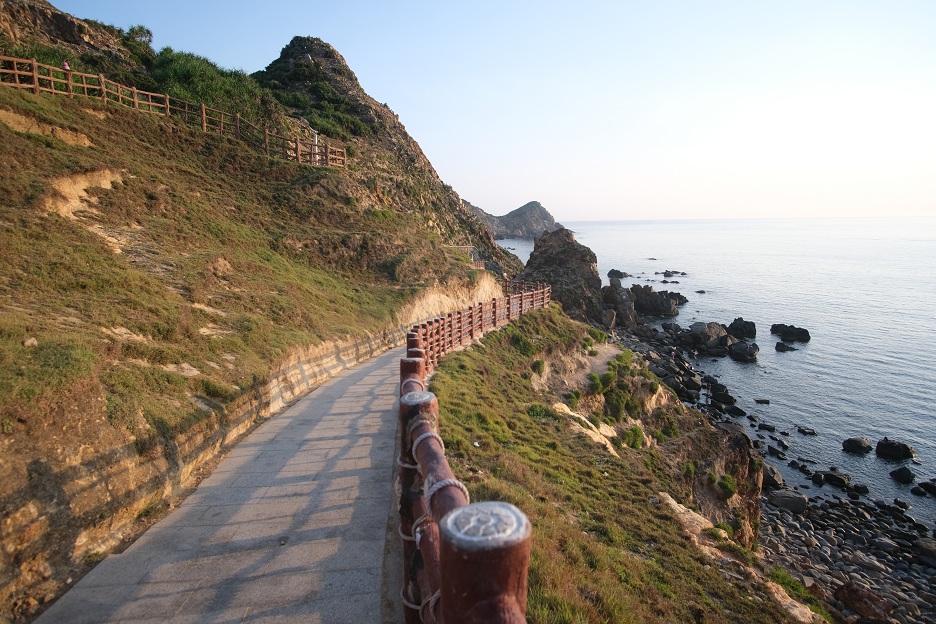
Eo Gio, Quy Nhon, BInh Dinh. Photo: TITC
Eo Gio located near Nhon Ly Beach, keeps in its wild beauty. It is surrounded by rocky mountains with many fancy shapes, creating a bend as if to embrace the beautiful strait. The unique and attractive feature of Eo Gio is made of rocks and water. At the foot of the mountain is De rock beach with bumpy paths. The rocks have been eroded from wind and sea water through time, so they have many interesting sizes and shapes. Besides, there are number of birdnest caves with funny names such as Ky Co cave, Ba Nghe cave, Bat cave, Suc Khoe (Health) cave...
Ky Co Beach
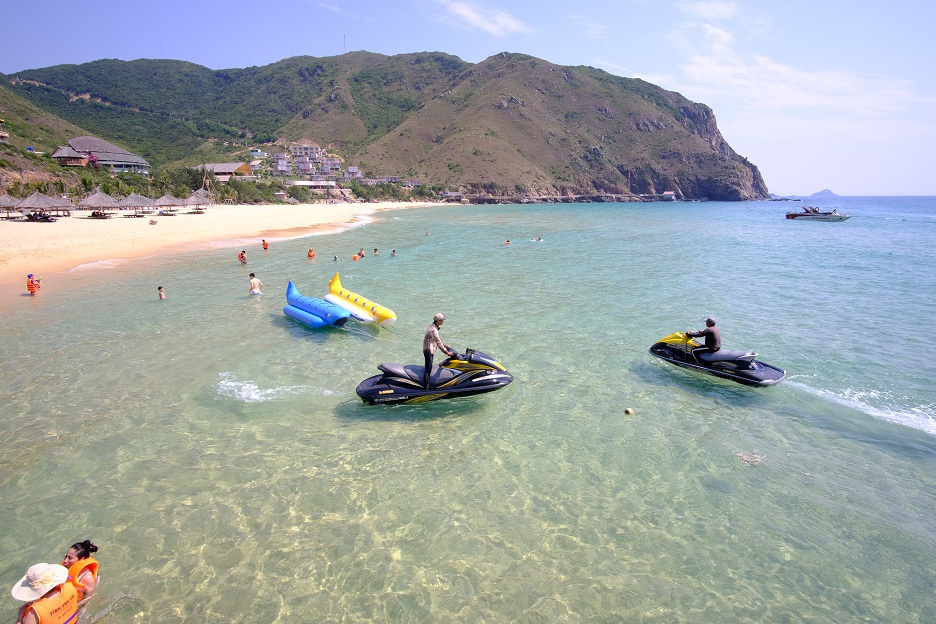
Ky Co Beach. Photo: TITC
Ky Co Beach with beautiful white sand lies between two giant rocky shores. Viewed from above, the scene panorama of Ky Co is majestic and magnificent. Coming here, visitors can walk along the beach to admire the poetic scenery of sky, sea and rocks, swim in the charming blue water and take a boat ride.
In the past, it could only take a boat to get to Ky Co (renting from the villages of Eo Gio, Nhon Ly, Xuong Ly or Nhon Hai), but recently, it is possible to take a car (or walk) along a beautiful road. It runs through the cliffs south of Eo Gio, to the last slope, all the distance of about 6km.
Nhon Hai Beach (south of the peninsula), where visitors discover the magical natural beauty of the rocky cliffs and other attractive unspoiled spots such as the top of Cot Co mount, the fishing village located close to the beach; especially a section of Champa ancient citadel located about 200m from the shore stretching straight, undulating on the waves. Walking, catching snails, prying oysters, fishing on the Champa ancient citadel that only rises to the sea surface at low tide, which is an extremely strange experience, only in Nhon Hai.
Hon Kho Island
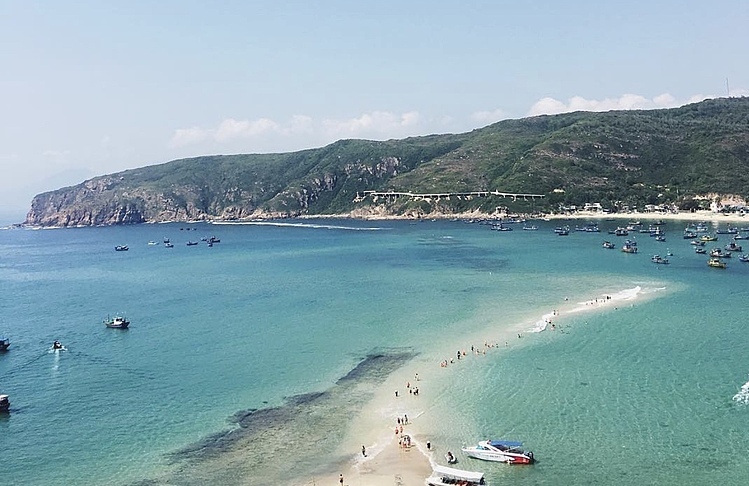
Hon Kho Beach with "path through the sea". Photo: internet
Hon Kho Island is located offshore near Nhon Hai Beach, attracting the curiosity and interest of visitors thanks to its clean water, fine white sand, green meadows and beautiful coral reefs.
An interesting time from March to September, visitors coming to Hon Kho can explore the unique "path through the sea" with more than 500 meters long, connecting two mountain ranges. This unique path is not always visible due to the tides rising and falling depending on the season. The path across the sea only appears at low tide, so visitors can wade to Hon Kho.
Local fishing villages
Phuong Mai Peninsula is home to a number of peaceful fishing villages located at the foot of the mountains on the beautiful coast such as Nhon Ly and Nhon Hai fishing villages... Here visitors can see many big crab cages, many boats, and meet many friendly fishermen.
Thi Nai Lagoon
With an area of over 5,000 hectares of water surface, stretching for more than 10 km and the widest place nearly 4 km, Thi Nai Lagoon is one of the largest saltwater lagoons in Binh Dinh. The lagoon converges by the flows of the tributaries of the Kon and Ha Thanh rivers. Charming landscape in the lagoon attracts tourists from near and far.
In the lagoon, there is Con Chim (Bird Island), which is considered as the green lung of Quy Nhon. With an area of nearly 1,000 hectares, Con Chim has an abundant ecosystem including a mangrove ecosystem and seagrass beds with up to 25 species, the fauna with 64 species of plankton, 76 species of fishes, and hundreds of bird species, including 23 species of waterfowl and migratory birds, 10 species of forest birds.
Unique relic sites on the peninsula
Ngoc Hoa Pagoda
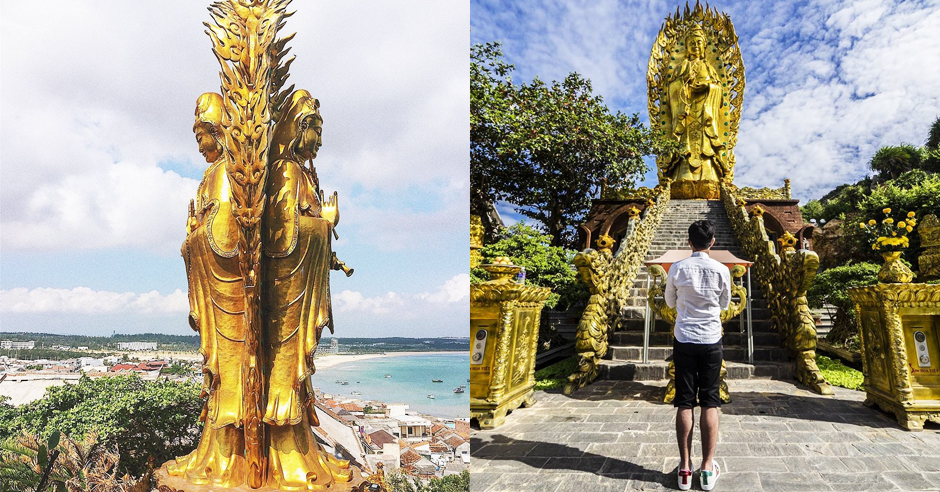
18m high double statue of Avalokitesvara (the highest in Viet Nam) in Ngoc Hoa Pagoda. Photo: internet
Near the mountainside of Eo Gio is the sacred space of Ngoc Hoa Pagoda, inaugurated in May 1962. The main hall is both ancient and modern. Ngoc Hoa Pagoda is famous for its 18m high double statue of Avalokitesvara (the highest in Viet Nam) with impressive architecture, looking in 2 directions. One facing the south, holding a rosary and a scripture, is called Avalokitesvara Khiet Tuong; the other facing the sea (north direction) and holding a pure water vase, is called Avalokitesvara Nam Hai. In the pagoda grounds, there is sacred tower, many statues such as Maitreya Buddha, four-face statue with a mysterious smile, and many old trees and ornamental plants.
Phat Loi (Buddha protruding) Pagoda
Phat Loi Pagoda is located in Hai Giang, Nhon Hai commune. The pagoda was built when the Hai Giang’s people accidentally discovered a stone Buddha statue protruding from the cultivated field at the foot of the hill about 200 years ago. In the pagoda, there is a sandstone statue with 80 cm high and 46 cm wide in the style of late Cham. The statue is crafted in the form of a Bodhisattva sitting in a meditation posture, and has the Sanskrit inscription in its back.
In addition, visitors can contemplate Ong Nui Pagoda (also called Linh Phong Pagoda) located on the top of Chop Vung Mount, Phu Cat District, in the north of the peninsula. The pagoda owns a huge statue of Buddha Shakyamuni with the height of 108m including the pedestal, diameter of the pedestal is 52m. From the pagoda's location, visitors can enjoy a panoramic view of Phuong Mai Peninsula, Nhon Hoi economic zone by Thi Nai lagoon.
Tran Hung Dao monument is located in the southwest of the peninsula, on Hai Minh hill at altitude of about 40 meters above sea level. Tran Hung Dao (1228-1300) was a talent general during Tran Dynasty. The monument was started building in 1972 and completed in 1973. With a height of 16 meters (including the pedestal), the statue of Tran Hung Dao was carved with armor and helmet, in a pose of standing on a dragon boat to command the battle of Bach Dang River.
FLC Zoo Safari Park
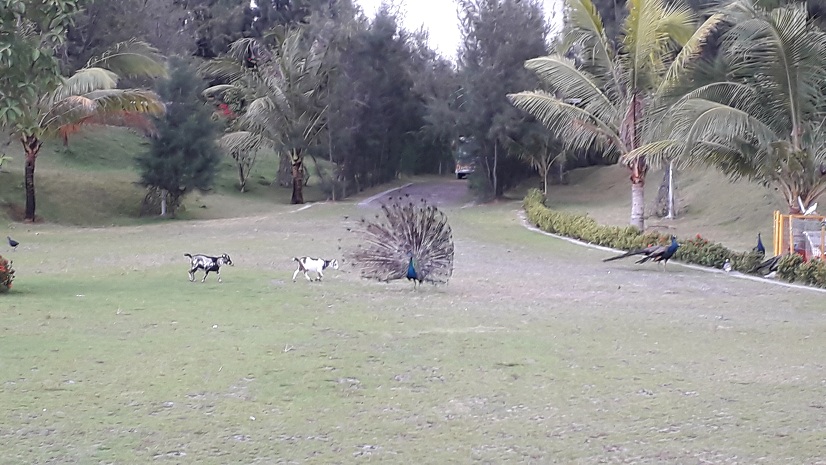
FLC Safari Park Photo: TITC
The park is about 9km north of Thi Nai Bridge (in Nhon Hoi side). With an area of 38.5 hectares, FLC Zoo Safari Park was built according to the semi-wild model, which homes nearly 900 individual animals. Rare and precious animals are cared for and preserved in a space close to the natural environment. This is biodiversity conservation, aiming to preserve rare and endangered animal genetic resources, and besides, bringing unique experiences to visitors.
The sand dunes in Phuong Mai are said to be ideal for sand boarding because of the height from 20m, the highest place to 100m above sea level and the moderate slope. Interestingly, the sand dunes often change shapes by the wind. The beautiful sand dunes are mainly located along both sides of National Highway 19B on Phuong Mai peninsula. Currently, this area is still quite wild.
Cuisines
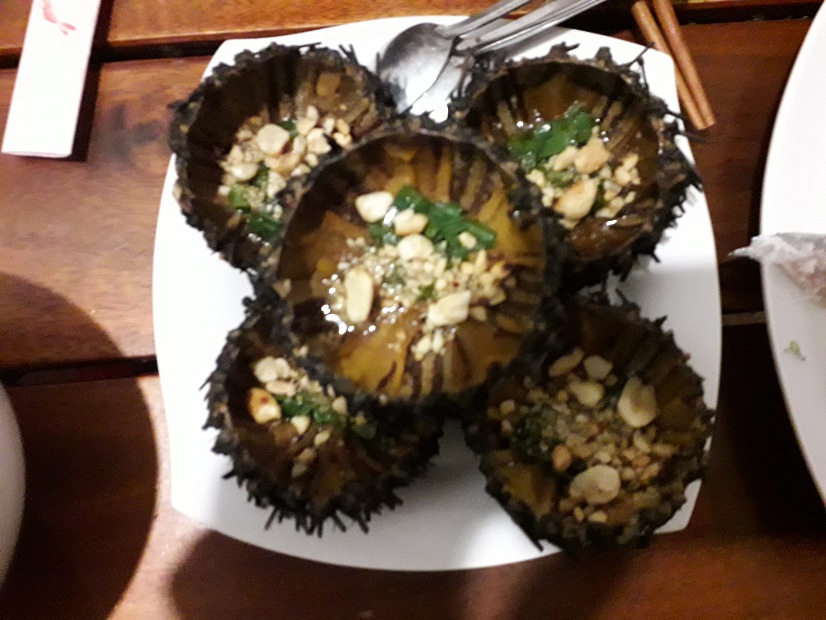
Sea urchins. Photo: TITC
Coming to Phuong Mai, visitors do not forget to enjoy many attractive specialties of Binh Dinh land such as Huynh De crab, shrimp rolls, lobster hot pot, sea urchin, grilled abalone with onion fat, sea snails (cellana nigrolineata), fish noodle, cake...
| Phuong Mai Tourist Zone (Binh Dinh Province) has been included in the list of potential sites to develop a national tourist zone (issued by the Decision No. 201/QD-TTg dated January 22, 2013 of the Prime Minister). Phuong Mai peninsula is far more than 10km from the city center of Quy Nhon and about 40km from Phu Cat airport. |
TITC